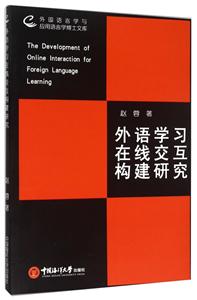-
>
考研英語背單詞20個詞根詞綴
-
>
西班牙語詞根寶典
-
>
美國K-12原版語文課本--初中·下(全12冊)
-
>
流浪地球劉慈欣
-
>
西南聯大英文課 輕讀禮盒版
-
>
英語大書蟲世界經典名譯典藏書系:中國人的精神 (英漢對照)(精選權威版本)
-
>
許淵沖譯唐詩三百首:漢文·英語
外語學習在線交互構建研究 版權信息
- ISBN:9787567008885
- 條形碼:9787567008885 ; 978-7-5670-0888-5
- 裝幀:一般膠版紙
- 冊數:暫無
- 重量:暫無
- 所屬分類:>
外語學習在線交互構建研究 本書特色
趙蓉編著的《外語學習在線交互構建研究(英文版)》共由七個部分構成。**部分是引言,主要介紹研究背景、研究問題、核心概念和組織框架。**章是文獻綜述,主要闡述了在線語言學習、在線學習學習成果、學習者繼續學習意愿、在線交互所涉及的各個理論,包括等效理論、在線學習社區組織框架理論、互動假設、社會文化理論、支架理論、TAM模型和ECM模型等。第二章是研究模型與假設,該章在TAM與ECM模型的基礎上。構建研究模型,探究外語在線學習中交互的建設,通過該交互建設對學習者繼續學習意愿的影響,驗證該交互建設的有效性。第三章是有關研究方法,具體包括問卷、訪談兩種方法,并通過結構方程分析所獲得的數據。第四章是討論,論文依據數據分析,對外語學習在線交互建設、交互建設與繼續學習意愿之間的關系,展開深入分析與科學探討。第五章是有關研究的理論貢獻與實踐運用。*后一部分是總結,主要指出研究的不足之處與今后的研究方向。
外語學習在線交互構建研究 內容簡介
《外國語言學與應用語言學博士文庫:外語學習在線交互構建研究(英文版)》共由七個部分構成。**部分是引言,主要介紹研究背景、研究問題、核心概念和組織框架。**章是文獻綜述,主要闡述了在線語言學習、在線學習學習成果、學習者繼續學習意愿、在線交互所涉及的各個理論,包括等效理論、在線學習社區組織框架理論、互動假設、社會文化理論、支架理論、TAM模型和ECM模型等。第二章是研究模型與假設,該章在TAM與ECM模型的基礎上。構建研究模型,探究外語在線學習中交互的建設,通過該交互建設對學習者繼續學習意愿的影響,驗證該交互建設的有效性。第三章是有關研究方法,具體包括問卷、訪談兩種方法,并通過結構方程分析所獲得的數據。第四章是討論,論文依據數據分析,對外語學習在線交互建設、交互建設與繼續學習意愿之間的關系,展開深入分析與科學探討。第五章是有關研究的理論貢獻與實踐運用。*后一部分是總結,主要指出研究的不足之處與今后的研究方向。
外語學習在線交互構建研究 目錄
1 Research Background
2 Statement of the Problem
3 Purpose of the Study
4 Conceptual Framework
5 Organization of the Dissertation
Chapter One Literature Review
Introduction
1.1 Online Language Learning
1.1.1 Online Education
1.1.2 Research Status of Online Language Learning
1.1.3 Foreign Language Learning
1.2 Benefits of Online Education
1.2.1 Organizational Framework of Online Learning Community
1.2.2 Sense of Community
1.3 Learners' Continuance Intention Toward Online Education"
1.3.1 TAM
1.3.2 ECM
1.4 Interaction in Distance Education
1.4.1 Definition
1.4.2 Instructional Interaction
1.4.3 System Interactivity
1.5 Equivalence Theory
1.5.1 Online Interactions with Learners
1.5.2 Equivalence Theory
1.6 Interaction Hypothesis (IH)
1.6.1 VersionsoflH
1.6.2 Deficiencies of IH
1.7 Socio-cultural Theory
1.7.1 ZPD
1.7.2 Mediation
1.7.3 Language, as a Symbolic Tool for Mediation
1.8 Scaffolding
1.8.1 Metaphor and Definition
1.8.2 Features and Functions of Scaffolding
1.8.3 Design of Scaffolding in Online Education
Summary
Chapter Two Research Model and Hypotheses
Introduction
2.1 Interaction in Online Language Learning
2.1.1 Interactivity and Scaffolding
2.1.2 Scaffolding Sources Versus Preconditions
2.1.3 Scaffolding Features and Dimensions
2.1.4 Scaffolding Dimensions and Scaffolding Types
2.2 Online Interaction and Continuance Intention
2.2.1 TAM
2.2.2 ECM
2.2.3 Sense of Community
2.2.4 Interaction Construction
2.2.5 Second-Order Construct of Scaffolding
Summary
Chapter Three Methodology
Introduction
3.1 Survey Instrument
3.1.1 0perationalizing the Second-Order Construct of Scaffolding
3.1.2 Developing the Survey Instrument
3.2 Pilot Test
3.3 Participants and Procedure
3.4 Analysis and Results
3.4.1 The Measurement Model
3.4.2 Common Method Bias
3.4.3 Hypothesis Testing
Summary
Chapter Four Discussion
Introduction
4.1 Online Interaction Construction
4.1.1 Integral Constituents of Online Interaction
4.1.2 Construction of Scaffolding
4.2 Correlation Between Interaction and Continuance Intention
Summary
Chapter Five Contributions and Implications
Introduction
5.1 Theoretical Contributions
5.2 Practical Implications
Summary
Conclusion
1 Summary of Contributions
2 Limitations
3 Directions for Future Research
Bibliography
Appendix
Appendix A: List of Items by Construct
Appendix B: Measurement Instrument
Appendix C: Chinese Version of Measurement Instrument.-
Appendix D: Construct Reliabilities, AVE and Correlations-
Appendix E: Item Loadings and Cross-Loadings
- >
隨園食單
- >
自卑與超越
- >
龍榆生:詞曲概論/大家小書
- >
唐代進士錄
- >
苦雨齋序跋文-周作人自編集
- >
煙與鏡
- >
伊索寓言-世界文學名著典藏-全譯本
- >
月亮與六便士
















